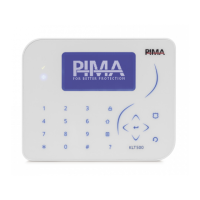6: CMS & Communications
17
6 CMS & Communications
The
CMS & Communications
menu includes the following sub-menus:
1) Monitoring Stations: see below.
2) PIMA Cloud; see section 6.2, on page 20.
3) General Settings; see section 6.1.3, on page 20.
4) Telephone Settings; see section 6.4, on page 21.
5) Network Settings; see section 6.5, on page 21.
6) Cellular Settings; see section 6.6, on page 22.
6.1 Monitoring Stations
System Configuration
CMS & Communications
Monitoring Stations
The
Monitoring Stations
menu includes the following sub-menus:
1) CMS 1-3; see below.
2) Radio; see section 6.1.2, on page 19.
3) Custom Zones Reports; see section 6.1.3, on page 20.
6.1.1 CMS 1-3
System Configuration
CMS & Communications
Monitoring Stations
CMS 1-3
You can configure up to 3
different CMS (monitoring station) independently. Each one can be
configured to communication paths, account IDs, telephone numbers and more. Force will
report the events to all the CMS's. Backup paths are defined within each CMS.
The
CMS 1-3
menu includes the following sub-menus:
1) Comm. Paths; see below.
2) Event Reporting: see page 18.
3) CMS Name: user text, up to 16 characters.
4) CMS Lock Code: set a lock code to the definitions of this CMS.
Communication Paths
System Configuration
CMS & Communications
Monitoring Stations
CMS 1-2
Comm. Paths
The
Communication Paths
menu includes the following sub-menus:
1) Telephone (PSTN).
The partitions’ ID number. If you only set partition 1’s
ID, it will serve for all other partitions.
Set up to four telephone numbers of the CMS (up to 16
digits per number).
Select the PSTN protocol between ContactID, SIA
10
, and
NPAF.
3 CMS is supported from Force firmware version 1.4.13 and up
Consult with PIMA support.

